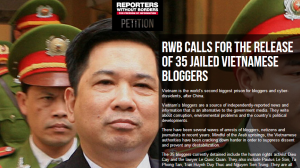
An aerial photo taken though the window of a Philippine military plane shows the alleged ongoing land reclamation by China of an island in the South China Sea, west of Palawan, Philippines, on May 11, 2015. Photo by Ritchie B. Tongo/Pool via Reuters
PBS | Jul 08, 2016
BY MICHAEL D. MOSETTIG
From Beijing to Washington and all across Asia, eyes will be on an obscure tribunal in the Hague this coming Tuesday. The panel’s words could mark a decisive next step in the growing territorial disputes between China and its Southeast Asia neighbors in the South China Sea — disputes some fear could lead to armed conflict between China and the United States.
The Tuesday ruling comes from a United Nations body with a clunky name, the Permanent Court of Arbitration for the United Nations Convention of the Law of the Sea. It will be ruling on claims brought by the Philippines against China, which effectively occupied the Scarborough Shoal off the Philippine coast four years ago.
And while China and other nations are parties to the Law of the Sea Convention, Beijing has consistently argued the tribunal has no standing and has promised to ignore its findings. (The U.S. Senate has never ratified the accord but successive administrations since 1980 have said they adhere to its provisions.)
This week, as tensions continue to mount in the South China Sea, China mobilized new firepower to defend its claims. For two days, Chinese think tank scholars pressed their country’s case to fellow think tankers and journalists in Washington.
But if the messengers are new, the message remains pretty much the same: China has sovereignty over much of South China Sea, inside the so-called nine-dash line that covers nearly two thirds of the water, much of it closer to other Asian nations than to mainland China. And that applies whatever countries such as the Philippines or Vietnam might suggest.
Their messages to Washington and the Obama administration were to respect that claim but also to be reassured that China respects freedom of navigation in waters where more than $5 trillion of trade passes every year.
In Washington, as they consistently do in Asia, Chinese representatives said the tribunal has no jurisdiction and that Beijing would not be bound by any ruling. At a Carnegie Endowment session Tuesday, before the U.S. and Chinese participants went into closed session, a former top ranking official Dai Bingguo dismissed the prospective ruling as “a scrap of paper.”
But a second message, which some in Washington partly acknowledged, was that all parties need to cool down their rhetoric and make sure maneuvering navy and coast guard ships and fishing boats don’t clash and open the door to wider military action.
The U.S. has stepped up military operations in the region, most recently dispatching two aircraft carriers off the Philippine coast in what it calls Freedom of Navigation operations. Those operations are routinely denounced as provocative in Beijing.

A Chinese Coast Guard vessel (right) passes near the Chinese oil rig, Haiyang Shi You 981 in the South China Sea, about 130 miles from the coast of Vietnam on June 13, 2014. Photo by Nguyen Minh/Reuters
But the future may not be controlled solely by the superpowers. The new president of the Philippines, Rodrigo Duterte, has both called for negotiations with China and threatened to ride a jet ski and plant his country’s flag on disputed rocks. The Philippines is a U.S. military treaty ally.
The official U.S. stand is that it has no position on the territorial disputes themselves but wants China to negotiate with all the members of the Association of Southeast Asian Nations (ASEAN).
China has said it will talk one by one with the smaller and weaker claimant countries. And even while the Chinese think tankers were pushing a more peace-seeking message in Washington, there were indications Beijing does not always maintain tight message control.
The Global Times, which often speaks for more hawkish elements, said China “must be prepared for any military confrontation.”
At a news conference, attended by far more Chinese than American reporters, the China think tankers avoided saber rattling. But, amid much legal discussion over the scope of the United Nations Convention of the Law of the Sea (which goes by the acronym UNCLOS) they held fast to the position that China has had legal control of much of the South China Sea since the end of World War II.
Three Chinese press conference participants and one American, U.S. Naval Academy professor Brendan Mulvaney, were in accord that the two sides need to keep talking and avoid incidents that could escalate between the two nuclear nations.
They agreed the Carnegie session, closed to the media and no U.S. government participants, was a good model for discussion.
Mulvaney said that no matter how the Hague tribunal rules, and its options are vast, it will take months to sort out the ramifications of the decision and whether it will reduce or inflame potential conflicts in the turbulent waters.
Height Insoles: Hi, I do believe this is an excellent site. I stumbledupon …
http://fishinglovers.net: Appreciate you sharing, great post.Thanks Again. Keep writi…
Achilles Pain causes: Every weekend i used to pay a quick visit this site, as i w…






July 9, 2016
Will China respect international court’s South China Sea decision?
by Nhan Quyen • [Human Rights]
An aerial photo taken though the window of a Philippine military plane shows the alleged ongoing land reclamation by China of an island in the South China Sea, west of Palawan, Philippines, on May 11, 2015. Photo by Ritchie B. Tongo/Pool via Reuters
PBS | Jul 08, 2016
BY MICHAEL D. MOSETTIG
From Beijing to Washington and all across Asia, eyes will be on an obscure tribunal in the Hague this coming Tuesday. The panel’s words could mark a decisive next step in the growing territorial disputes between China and its Southeast Asia neighbors in the South China Sea — disputes some fear could lead to armed conflict between China and the United States.
The Tuesday ruling comes from a United Nations body with a clunky name, the Permanent Court of Arbitration for the United Nations Convention of the Law of the Sea. It will be ruling on claims brought by the Philippines against China, which effectively occupied the Scarborough Shoal off the Philippine coast four years ago.
And while China and other nations are parties to the Law of the Sea Convention, Beijing has consistently argued the tribunal has no standing and has promised to ignore its findings. (The U.S. Senate has never ratified the accord but successive administrations since 1980 have said they adhere to its provisions.)
This week, as tensions continue to mount in the South China Sea, China mobilized new firepower to defend its claims. For two days, Chinese think tank scholars pressed their country’s case to fellow think tankers and journalists in Washington.
But if the messengers are new, the message remains pretty much the same: China has sovereignty over much of South China Sea, inside the so-called nine-dash line that covers nearly two thirds of the water, much of it closer to other Asian nations than to mainland China. And that applies whatever countries such as the Philippines or Vietnam might suggest.
Their messages to Washington and the Obama administration were to respect that claim but also to be reassured that China respects freedom of navigation in waters where more than $5 trillion of trade passes every year.
In Washington, as they consistently do in Asia, Chinese representatives said the tribunal has no jurisdiction and that Beijing would not be bound by any ruling. At a Carnegie Endowment session Tuesday, before the U.S. and Chinese participants went into closed session, a former top ranking official Dai Bingguo dismissed the prospective ruling as “a scrap of paper.”
But a second message, which some in Washington partly acknowledged, was that all parties need to cool down their rhetoric and make sure maneuvering navy and coast guard ships and fishing boats don’t clash and open the door to wider military action.
The U.S. has stepped up military operations in the region, most recently dispatching two aircraft carriers off the Philippine coast in what it calls Freedom of Navigation operations. Those operations are routinely denounced as provocative in Beijing.
A Chinese Coast Guard vessel (right) passes near the Chinese oil rig, Haiyang Shi You 981 in the South China Sea, about 130 miles from the coast of Vietnam on June 13, 2014. Photo by Nguyen Minh/Reuters
But the future may not be controlled solely by the superpowers. The new president of the Philippines, Rodrigo Duterte, has both called for negotiations with China and threatened to ride a jet ski and plant his country’s flag on disputed rocks. The Philippines is a U.S. military treaty ally.
The official U.S. stand is that it has no position on the territorial disputes themselves but wants China to negotiate with all the members of the Association of Southeast Asian Nations (ASEAN).
China has said it will talk one by one with the smaller and weaker claimant countries. And even while the Chinese think tankers were pushing a more peace-seeking message in Washington, there were indications Beijing does not always maintain tight message control.
The Global Times, which often speaks for more hawkish elements, said China “must be prepared for any military confrontation.”
At a news conference, attended by far more Chinese than American reporters, the China think tankers avoided saber rattling. But, amid much legal discussion over the scope of the United Nations Convention of the Law of the Sea (which goes by the acronym UNCLOS) they held fast to the position that China has had legal control of much of the South China Sea since the end of World War II.
Three Chinese press conference participants and one American, U.S. Naval Academy professor Brendan Mulvaney, were in accord that the two sides need to keep talking and avoid incidents that could escalate between the two nuclear nations.
They agreed the Carnegie session, closed to the media and no U.S. government participants, was a good model for discussion.
Mulvaney said that no matter how the Hague tribunal rules, and its options are vast, it will take months to sort out the ramifications of the decision and whether it will reduce or inflame potential conflicts in the turbulent waters.